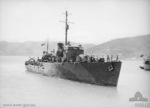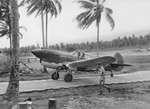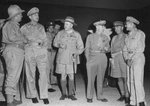
Australian Papua
| Full Name | 73 Territory of Papua | |
| Alliance | Allies - Minor Member Nation or Possession | |
| Possessing Power | Australia | |
| Entry into WW2 | 3 Sep 1939 |
Contributor: C. Peter Chen
ww2dbaseIn 1883, the United Kingdom claimed the southeastern quarter of New Guinea Island, creating a protectorate in the following year. In 1888, British New Guinea was officially formed with Port Moresby as its capital. In 1906, five years after Australian gained Dominion status, the British turned over the territory over to the Australians, who renamed the territory Papua, a name originated from the 16th Century explorer Don Jorge de Meneses. In the opening chapters of WW2, Australian Territory of New Guinea to the north and Dutch New Guinea to the west were taken by the Japanese, and Australian Papua became the aim of the Japanese subsequent operations. In Mar 1942, Japanese troops landed at Lae and Salamaua on the northern coast. In Jul 1942, after the Battle of the Coral Sea and the Battle of Midway, Japanese Navy lost the offensive momentum, and the Japanese Army embarked on an ambitious over-land invasion toward Port Moresby over the treacherous Kokoda Track through the Owen Stanley Mountain Range, with a second prong of the attack landing on the coast of Milne Bay to the east. To support this effort, Japanese bombers from Rabaul, New Britain harrased the Allied airfields at Port Moresby. At a high cost, Australian troops fended off the Japanese attack at Milne Bay by Sep 1942, and Allied fighters gradually won the battle of attrition in the skies over Papua. Although the Japanese were able to reach within sight of Port Moresby, the combined Australian-American defensive efforts were able to turn back the offensive. By Jan 1943, Allied troops captured the Japanese supply ports on the northern coast of Papua, ending the Japanese threat on Papua.
ww2dbaseIn 1942, the Australian New Guinea Administrative Unit was formed to provide efficient war-time civilian leadership over the two separate Australian territories in eastern New Guinea island, the Territory of New Guinea to the north and Australian Papua to the south. After the war, the Papua New Guinea Provisional Administration Act of 1945-1946 was passed, officially creating a single administrative body, although the two territories were still separate. In 1949, the Papua and New Guinea Act was passed, creating a single entity named the Territory of Papua and New Guinea. In 1972, self government was granted, leading up to the 1975 independence of the nation of Papua New Guinea.
ww2dbaseSource: Wikipedia
Last Major Update: Dec 2012
| Events Taken Place in Australian Papua | ||
| New Guinea-Papua Campaign, Phase 2 | 8 Mar 1942 - 4 Mar 1943 | |
| New Guinea-Papua Campaign, Phase 3 | 30 Sep 1943 - 23 May 1945 | |
| Facilities | ||
| Dobodura Airfield | Air Base | |
Weather
WW2-Era Weather Data for Australian Papua
Photographs
 |  |  |  |
Australian Papua in World War II Interactive Map
Please consider supporting us on Patreon. Even $1 per month will go a long way! Thank you. Please help us spread the word: Stay updated with WW2DB: |
Visitor Submitted Comments
All visitor submitted comments are opinions of those making the submissions and do not reflect views of WW2DB.
- » Wreck of M-49 Found (10 Apr 2025)
- » Japanese Emperor Visited Iwoto (Iwo Jima) (8 Apr 2025)
- » Race, Holocaust, and African-American WW2 Histories Removed from the US Naval Academy Library (7 Apr 2025)
- » US Government Plans to Purge WW2 Information (17 Mar 2025)
- » See all news
 |
- » 1,167 biographies
- » 337 events
- » 44,606 timeline entries
- » 1,243 ships
- » 350 aircraft models
- » 207 vehicle models
- » 376 weapon models
- » 123 historical documents
- » 261 facilities
- » 470 book reviews
- » 28,500 photos
- » 365 maps
Winston Churchill, on the RAF
Please consider supporting us on Patreon. Even $1 a month will go a long way. Thank you!
Or, please support us by purchasing some WW2DB merchandise at TeeSpring, Thank you!
9 Apr 2013 12:56:04 AM
Papua, New Guinea became an independent member of the Commonwealth in 1975